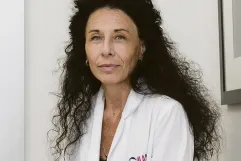
The need to break the "glass ceiling"
The figures show that achieving parity in all areas remains a challenge for the medical profession. However, it is fair to say that considerable progress has been made.
Fortunately, the old days when, in the health sector, women were very present in the field of nursing, but less present in the field of medicine, have been left behind. For some time now, we have found women in all positions and areas of the medical staff, although, as Dr. Martínez Nadal points out, "men still tend to choose more interventionist specialities, such as those involving regular surgical practice, and women are clearly in the majority in paediatrics, for example".
Dr. Lourdes Fernández de Bobadilla, a specialist in general surgery and digestive system and coordinator of the Breast Unit at HLA Moncloa University, says that "while it is true that in medical specialties female participation reaches 70%, there are publications that show that in the surgical specialties the percentage is lower, but reaching almost 50%, so it is clear that women are getting into what they really like". In any case, these old inertias are being abandoned with the incorporation of new generations: for example, when Dr Sánchez Molina began her urology residency more than a decade ago, she was the only woman in this speciality. Now, in many hospitals, female urologists are in the majority.
In December 2022, the Federation of Spanish Scientific Medical Associations (FACME) presented a pioneering study entitled Women in Medicine in Spain (WOMEDS), which analysed the percentage of female doctors reaching leadership positions in four different areas: healthcare, participation in professional organisations (such as scientific societies, medical congresses or professional associations), in the academic world and in research. The results, compiled over the period 2019-2021, can in part be seen as encouraging. At the same time, they reflect that there is still much work to be done.

Despite being a majority in many health centres (in June 2021, 61% of doctors in public health care in Spain were women), the famous "glass ceiling" still remains. As Beatriz González, professor of health economics, explained at the presentation of the study, there is still a low percentage of women in charge of departments, ranging from 20.3% in Andalusia to 46.7% in Navarra. The figures for female heads of departments range from 24.8 % in Aragon to 53.2 % in Navarra.
In Catalonia, the aforementioned study by Metges de Catalunya confirms that 53% of the women surveyed say that the positions of responsibility in their workplaces are held by men. The truth is that the Institut Català de la Salut, with a staff made up of 75% women, only has 30% of these professionals in management or leadership positions. This means giving up a lot of talent, especially if we take into account - as Dr. Sánchez Molina points out - that "women tend to be particularly consistent and studious, so it is common for them to have the best CVs" of their promotions.
The figures show that achieving parity in all areas remains a challenge for the medical profession. However, it is fair to say that considerable progress has been made. The numbers of women entering our universities each year confirm that the vocation of female students for medicine remains strong. The same is true for those who are already practising. When we asked the interviewees what they would do if they had to go back in time to decide what career to study, all of them were clear: medicine would again be their first choice.



